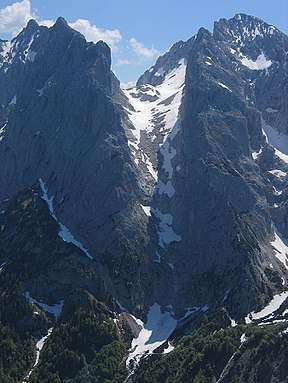Couloir

A couloir (French: [ku.lwaʁ], "passage" or "corridor"), is a narrow gully with a steep gradient in a mountainous terrain.[1]
Geology
A couloir may be a seam, scar, or fissure, or vertical crevasse in an otherwise solid mountain mass. Though often hemmed in by sheer cliff walls, couloirs may also be less well-defined, and often simply a line of broken talus or scree ascending the mountainside and bordered by trees or other natural features. Couloirs are especially significant in winter months when they may be filled in with snow or ice, and become much more noticeable than in warmer months when most of the snow and ice may recede. These physical features make the use of couloirs popular for both mountaineering and skiing.
Winter Sports
While in the United States such terrain features are uncommon at ski resorts, in Europe they are more common. Couloirs are frequently considered an off-piste trail and, as such, are not marked on ski piste maps. Some exceptions to this include:
- The Grand Couloir in Courchevel, France, which has historically variable classifications but is now graded as a black run under French piste difficulty grading
- The Massif du Mont Blanc, which has many well-known, celebrated, and frequently visited couloirs
- Gervasutti Couloir
- Breche Nonne Couloir
- Chevalier Couloir
- Cosmiques couloirs
- Jackson Hole Mountain Resort's Corbet's Couloir
- Sugar Bowl Ski Resort in California's run called "Nancy's Couloir"
- Big Sky Resort in Montana's
- "Big Couloir" run, which at a 50 degree pitch for over 1,000 feet of vertical is one of the most intense in-bounds trails in America
- Little Couloir, a lesser-known run located just to the side of Big Couloir, which has an even steeper pitch between 55 and 60 degrees, with the entry about 59 degrees.
- The double black diamond run on Blackcomb Mountain in Whistler, British Columbia, Canada, called "Couloir Extreme", which is located inside the Whistler-Blackcomb resort boundaries and can be accessed via chairlift
- The Norton Couloir, on the north face of Mount Everest, was descended by snowboard for the first time by French snowboarder Marco Siffredi in 2001.
Gallery
 "Red Couloir" in the Polish Tatra Mountains
"Red Couloir" in the Polish Tatra Mountains